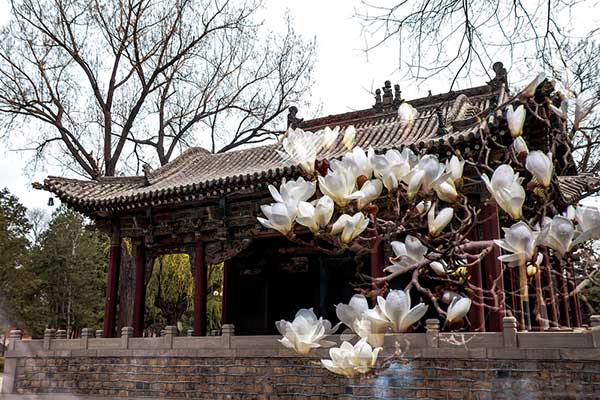Jinci, a temple for 3,000 years
By Li Yang And Sun Ruisheng In Taiyuan ( China Daily ) Updated: 2015-05-30 07:44:39
 |
|
[Photo by Sun Ruisheng/China Daily] |
On the north of the middle line are 10 halls for the worship of gods in charge of education, life, wealth, Taoism and land, and in memory of Ji Yu. These buildings stand on a patch of mountain slope. Although they were separately constructed in different dynasties, the architects were careful to leave space that borrows natural scenic views such as the mountain peak in the distance, a stretch of water surface or a patch of flourishing old trees, for their future peers to build new buildings.
To the south of the middle line are three pavilions and four temple halls for the worship of virtuous court officials and a well-respected local woman. Buildings in the southern part take on characteristics of the gardens to the south of the Yangtze River, that emphasize the combination of plants, water, stones and buildings.
Many of the buildings are well protected. Unlike the Forbidden City in Beijing which has been redecorated with fresh paint, most buildings in Jinci look natural with old wooden surfaces polished by years of wind and rains, and have a smell of age.
Apart from these masterpiece buildings that co-exist harmoniously with one another and nature, what makes Jinci a must-see is that every building in it has large amounts of original artistic works, be they clay sculptures, stone tablets inscribed by ancient calligraphers, delicate frescos or plaques written by emperors.
Every house looks like a museum. Take the clay sculptures, for example. In Yijiang Hall, there are over 50 clay sculptures that are the size of a real person, whose facial expressions and gestures are so vivid that the visitor can sense their emotions. The color of the sculptures, which were made between the Song Dynasty and the Qing Dynasty (1644-1911), is well preserved and they are important research materials for archaeologists.
Thanks to its close connection with royal families, who attached great significance to their family names and usually awarded their family name as a noble prize, over the long period of time, Jinci was regarded as the origins of many big family names such as Li and Zhang.
It takes about two hours to walk around the temple. Yet, visitors who are interested in Chinese history and culture can spend one day in Jinci, because there are not only the views aforementioned, but also many interesting legendary stories associated with the temple park. Some background knowledge of the Zhou, Tang and Song dynasties will be useful in understanding the soul of Jinci.
|
|
|
|
|
|
|
|

























 Raymond Zhou:
Raymond Zhou: Pauline D Loh:
Pauline D Loh: Hot Pot
Hot Pot Eco China
Eco China China Dream
China Dream China Face
China Face






